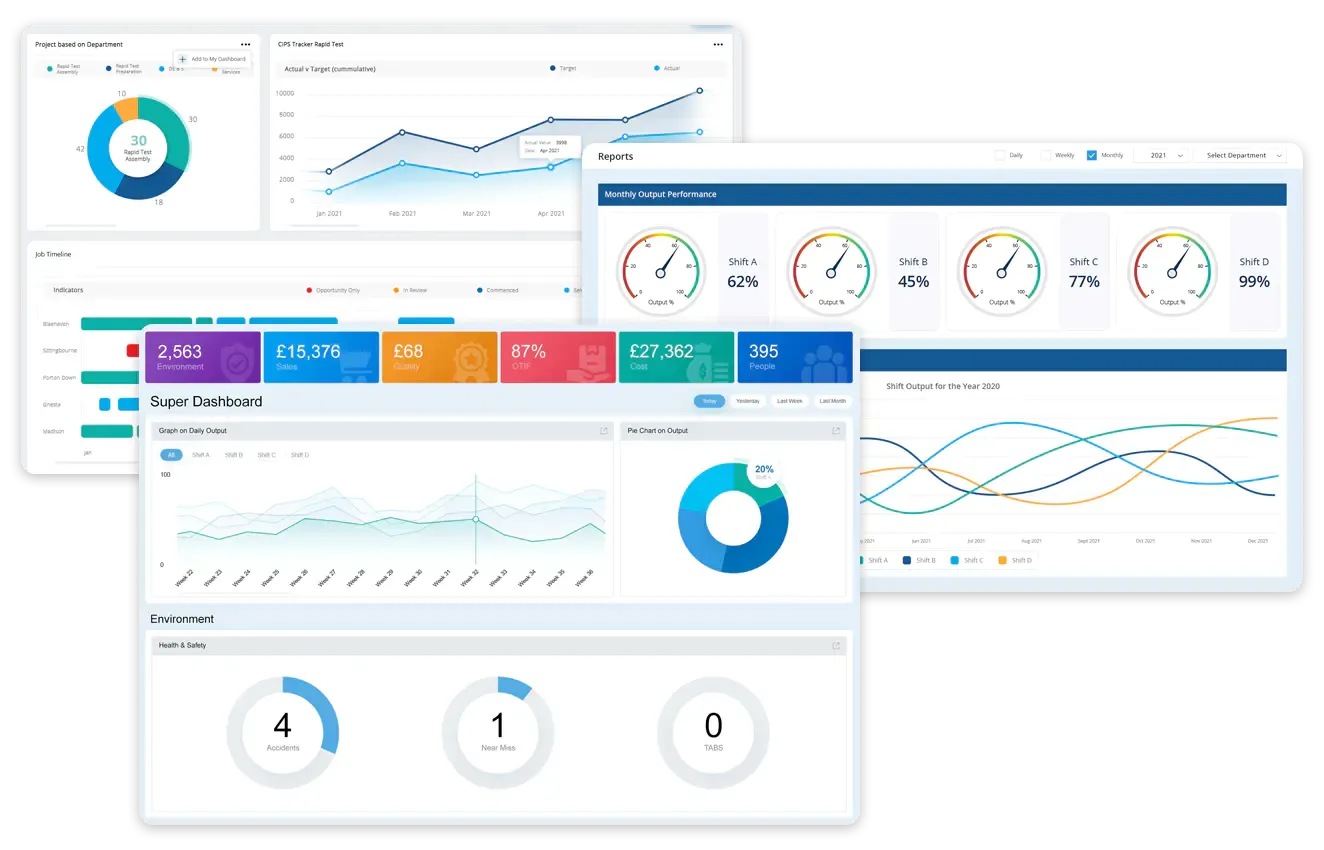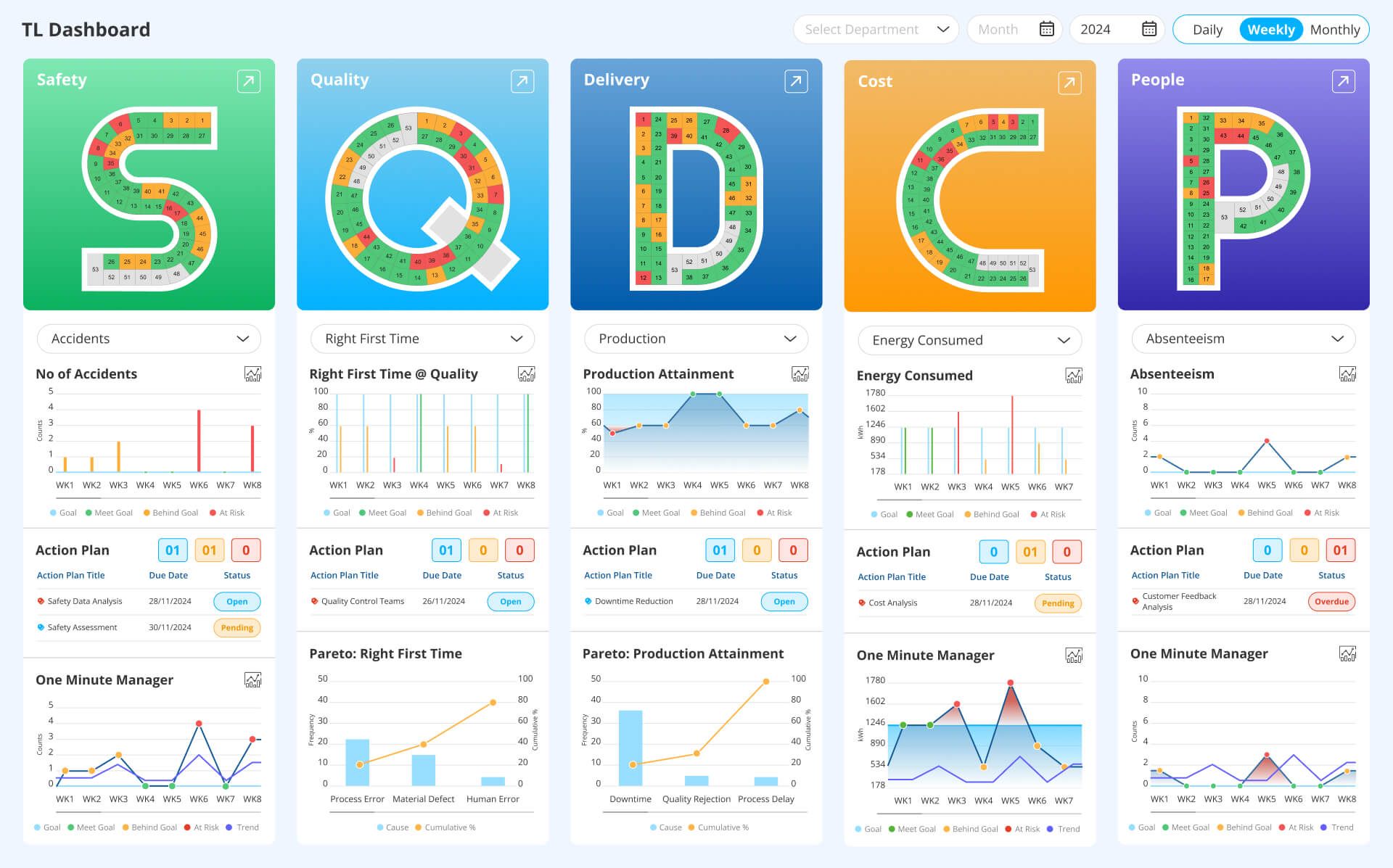Healthcare dashboard: 15 essential KPIs you need to assess and how it helps in real time
Operational healthcare indicators
1. Bed occupancy rate- Measures the percentage of hospital beds currently in use or within a time frame.
➜ How it helps- monitor capacity, patient flow and facility utilisation in real time
2. Admission rate-Tracks the number of patients admitted over a specific period.
➜ How it helps -Forecast demand, revenue and allocate resources accordingly
3. Emergency room (ER)/ patient wait time-Average time patients wait before being seen in the ER provider or healthcare staff.
➜ How it helps -Critical for assessing responsiveness and resource allocation
4. Staff-to-patient ratio- Compares the number of healthcare staff to patients. If lower the staff patient ratio better the compliance.
➜ How it helps -Ensures safe staffing levels and balanced workloads
5. Equipment uptime-Measures how often critical medical equipment is available and functional regularly and during emergency.
➜ How it helps -Supports operational continuity and patient safety (PSIRF) on demand
6. ER duration of treatment- Time from ER admission to first medical intervention.
➜ How it helps - Indicates responsiveness and emergency care efficiency
7. Training completion rate for staff- Percentage of employees who complete required training.
➜ How it helps-Ensures readiness, safety, and regulatory compliance
Clinical healthcare indicators
8. Average length of stay (ALOS)-Tracks how long patients stay in the hospital on average.
➜ How it helps -Indicates efficiency of care and discharge processes in real time
9. Mortality rate-Tracks the number of patient deaths relative to admissions.
➜ How it helps- Used to assess clinical outcomes and quality of care
10. Follow-up compliance rate- Evaluates how many discharged patients complete recommended follow-ups and how healthcare providers deal with.
➜ How it helps -Indicates continuity of care and long-term outcomes
11. Medication error rate (ER)-Tracks the frequency of incorrect medication, dosage, administration due to lake of training or workload.
➜ How it helps-Vital for patient safety and clinical accuracy instantaneously
12. Patient satisfaction rate- how patients feel about their care experience.
➜ How it helps -Influences service quality, reputation, and retention continuously
13. Readmission rate-Percentage of patients readmitted within a set period after discharge.
➜ How it helps -Reflects quality, healthcare equity and effectiveness of treatment plans. If readmission is high, it means quality of healthcare is low
Financial healthcare indicators
14. Insurance claim processing/ denial time-Average time taken to health insurance plan to process or deny insurance claims. Lesser the denial the better healthcare system performs, as they don’t want to bother about financial constraints.
➜ How it helps- Impacts cash flow, financial performance and affordable health insurance
15. Net profit margin – Measures the percentage of total revenue that remains as profit after all expenses are deducted.
➜ How it helps – calculate operating margin, financial health, out of pocket expenditure (OOPE), operational efficiency, and long-term sustainability. A higher operating margin suggests better cost control and strong revenue generation across services
Build a centralised digital dashboard with healthcare BSC
Once KPIs are defined, the next step is integrating them into a centralised digital healthcare BSC dashboard rather than manual or paper reports.
A Balanced Scorecard (BSC) is a strategic management framework that helps organisations translate their vision and strategy into measurable objectives across multiple dimensions, not just financial performance.
This healthcare balanced scorecard offers: Live data feeds from clinical systems, IoT devices, and operational platforms, customisable views for different roles like nurses, administrators, executives for easy management, automated alerts for sudden breaches and errors, historical analytics for trend analysis and forecasting.
Such dashboards empower healthcare teams to detect inefficiencies, respond to emergencies, and maintain compliance in real time.
Enabling real-time healthcare visibility with Data Point Balanced Scorecard
Our product, Data Point- the advanced Balanced Scorecard software by LTS, steps in as a game-changing tool for hospitals and care networks.
🔹Customisable dashboards
- Tailor views for clinical, operational, and financial KPIs
- Enables each department to monitor the metrics that matter most to them
🔹Real-time analysis
🔹Automated reporting
- Generates scheduled and on-demand reports automatically
- Saves admin time and ensures consistent reporting accuracy
🔹Data integration
- Seamlessly connects to EHRs, finance tools, and other systems
- Delivers a unified view of performance across the organisation
🔹Strategy mapping
- Visualises the link between goals, initiatives, and key metrics
- Strengthens alignment between lean daily operations and strategic planning
🔹Alerts and notifications
- Flags deviations from target metrics with real-time alerts
- Enables proactive management of performance issues or risks
🔹Role-based access
- Provides secure, customised access for leaders, clinicians, and staff
- Ensures privacy and focuses users on their relevant data areas
🔹Continuous improvement tools
- Includes feedback loops and historical trend analysis
- Promotes a culture of learning, adaptability, and sustained improvement
How it supports real-time tracking in healthcare system?
- Tracks patient centred goals like patient satisfaction, clinical outcomes, staff efficiency, and resource utilisation as they happen
- Enables early detection of safety events like medication errors or hospital-acquired infections
- Monitors wait times, discharge processes, and cost per patient to optimise care delivery
- Provides live KPI monitoring and management that help teams respond quickly and make informed decisions
- Empower your team through cross-departmental collaboration
- Use accurate data to guide your decision-making process focusing on security and data privacy
- Plan healthcare strategy by understanding its unique challenges for continuous improvement
Healthcare visibility starts here-try Data Point Balanced Scorecard now

